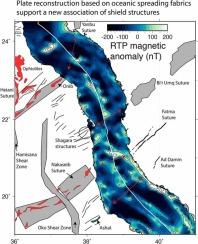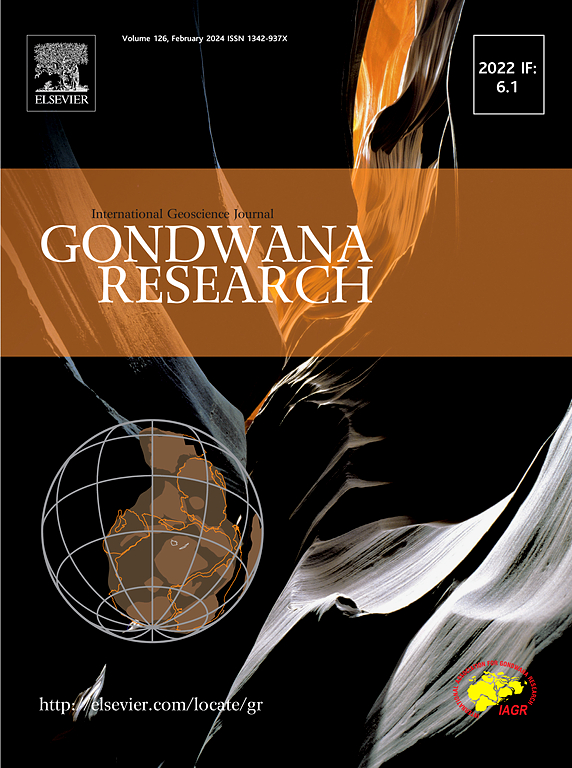Nubia-Arabia separation: Clues from oceanic spreading fabric in the Red Sea
IF 7.2
1区 地球科学
Q1 GEOSCIENCES, MULTIDISCIPLINARY
引用次数: 0
Abstract
The breakup of the Arabian-Nubian (Ar-Nu) shield created the Red Sea rift, a young continental rift transitioning to an ocean basin. Different Ar-Nu plate reconstruction models have emerged, which complicate interpreting the shield geology, reconstructing motions of other plates and leave open the question of how much oceanic crust underlies parts of the sea. Uncertainty of plate reconstructions also affects how we interpret the dynamics of rifting in this basin from geophysical data. Helping to address this issue, gravity anomalies reveal an oceanic segmentation fabric that constrains the opening direction since ∼ 10 Ma or half the total Ar-Nu movement. We derive an Euler plate reconstruction pole from that fabric and apply it to restore the configuration of Ar-Nu shield structures at ∼ 10 Ma. With the Ar and Nu structures brought closer together, the reconstruction supports a new association of those structures across the Red Sea. That association in turn constrains the pre-breakup relative positions of the Ar-Nu shield fragments in a NW-SE sense (i.e., rift obliquity). It allows us to prioritise earlier-published total opening Euler poles that also bring these structures together. In particular, one of them was derived using the known Dead Sea Transform (DST) and Suez Rift motions, which constrain total Ar-Nu separation magnitude and direction. New Moho depth estimates further allow an assessment of how much distributed extension has left coastal units displaced relative to plate interiors. Applying the total-opening pole, and allowing for those coastal displacements, the pre-breakup shield terranes of the two sides are brought together but with significant gaps remaining between the two sides. The results support the views that the northern Red Sea is underlain largely by stretched continental crust and that the central Red Sea is underlain by both continental and oceanic crust.

努比亚-阿拉伯分离:来自红海海洋扩张结构的线索
阿拉伯-努比亚(Ar-Nu)地盾的分裂形成了红海裂谷,这是一个年轻的大陆裂谷向海洋盆地过渡。不同的Ar-Nu板块重建模型已经出现,这使得解释地盾地质、重建其他板块的运动变得复杂,并留下了一个悬而未决的问题,即在部分海洋之下有多少海洋地壳。板块重建的不确定性也影响了我们如何从地球物理数据中解释该盆地的裂谷动力学。为了解决这个问题,重力异常揭示了一个海洋分割结构,该结构自 ~ 10 Ma或总Ar-Nu运动的一半以来限制了开放方向。我们从该织物中推导出欧拉板重构极,并应用它来恢复 ~ 10 Ma的Ar-Nu屏蔽结构的构型。随着Ar和Nu结构的紧密结合,重建支持了这些结构在红海上的新联系。这种联系反过来又在NW-SE意义上限制了Ar-Nu盾构破碎前的相对位置(即裂谷倾角)。它允许我们优先考虑早期发表的总开放欧拉极,这些欧拉极也将这些结构结合在一起。特别是,其中一个是利用已知的死海变换(DST)和苏伊士裂谷运动推导出来的,它们限制了总Ar-Nu分离的幅度和方向。新的莫霍深度估计进一步允许评估相对于板块内部有多少分布伸展使海岸单元位移。应用全开极,并考虑到这些海岸位移,两侧的解体前盾构地形被聚集在一起,但两边之间仍有明显的间隙。研究结果支持了这样的观点,即红海北部主要是由拉伸的大陆地壳构成的,而红海中部是由大陆地壳和海洋地壳共同构成的。
本文章由计算机程序翻译,如有差异,请以英文原文为准。
求助全文
约1分钟内获得全文
求助全文
来源期刊

Gondwana Research
地学-地球科学综合
CiteScore
12.90
自引率
6.60%
发文量
298
审稿时长
65 days
期刊介绍:
Gondwana Research (GR) is an International Journal aimed to promote high quality research publications on all topics related to solid Earth, particularly with reference to the origin and evolution of continents, continental assemblies and their resources. GR is an "all earth science" journal with no restrictions on geological time, terrane or theme and covers a wide spectrum of topics in geosciences such as geology, geomorphology, palaeontology, structure, petrology, geochemistry, stable isotopes, geochronology, economic geology, exploration geology, engineering geology, geophysics, and environmental geology among other themes, and provides an appropriate forum to integrate studies from different disciplines and different terrains. In addition to regular articles and thematic issues, the journal invites high profile state-of-the-art reviews on thrust area topics for its column, ''GR FOCUS''. Focus articles include short biographies and photographs of the authors. Short articles (within ten printed pages) for rapid publication reporting important discoveries or innovative models of global interest will be considered under the category ''GR LETTERS''.
 求助内容:
求助内容: 应助结果提醒方式:
应助结果提醒方式:


